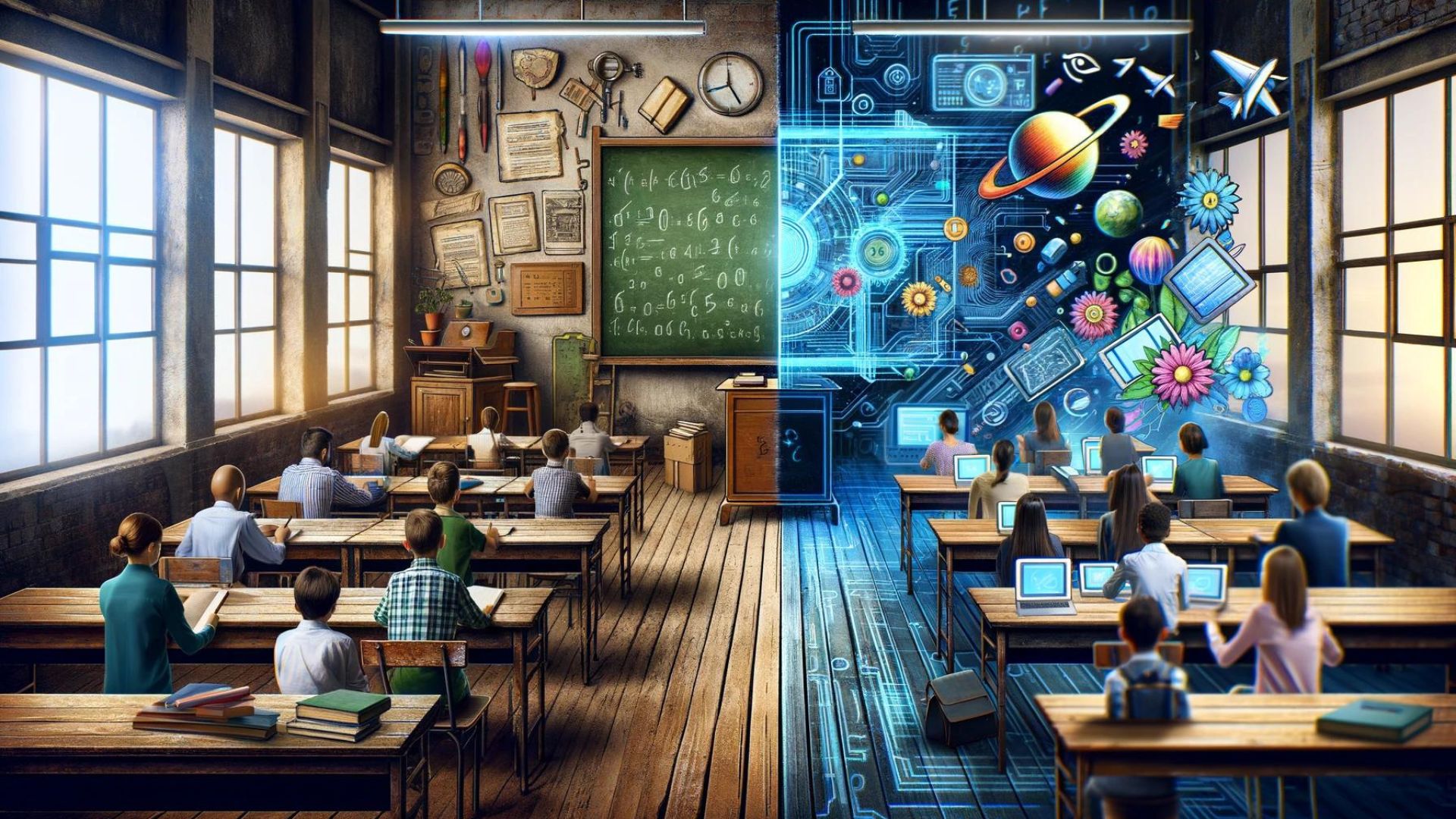The Schoolhouse Time Warp: Why Our Education System Needs a Reboot
Imagine stepping into a time machine and traveling back to the early 1900s. You’d find classrooms with rows of desks, teachers lecturing from the front, and students passively absorbing information. Now, snap back to the present day. Surprise! For many students, the classroom experience hasn’t changed much at all.
This is the problem of outdated education systems. They’re stuck in a bygone era, designed for a world that no longer exists. Today’s students need to be prepared for a rapidly changing, technology-driven society that demands creativity, critical thinking, and collaboration. But too often, they’re being taught in ways that stifle these essential skills.
Think about it: Do you remember most of what you learned in school through rote memorization? Probably not. Yet, that’s still the dominant mode of instruction in many classrooms. It’s time to break free from this outdated model and embrace a new vision for education.
The Call for Change
The good news is that there’s a growing movement to overhaul outdated education systems. Educators, policymakers, and parents are recognizing the need for change and are demanding a more student-centered, relevant, and engaging approach to learning.
So, what does a modern education system look like? Here are a few key features:
- Personalized Learning: Students learn at their own pace and in ways that cater to their individual strengths and interests. This might involve using adaptive technology, flexible learning pathways, or project-based learning.
- Real-World Relevance: The curriculum focuses on skills and knowledge that are applicable to the modern workplace and society. This includes critical thinking, problem-solving, communication, collaboration, and digital literacy.
- Student Agency: Students are active participants in their learning, not just passive recipients of information. They’re encouraged to ask questions, explore their passions, and take ownership of their education.
- Teacher as Facilitator: Teachers act as guides and mentors, helping students navigate their learning journey and discover their own potential. They collaborate with colleagues, share best practices, and continuously adapt their instruction to meet student needs.
- Technology Integration: Technology is seamlessly integrated into the learning experience, not just as a tool for consumption, but as a platform for creation, collaboration, and communication.
Real-World Examples
Some schools and districts are already leading the way in modernizing education. High Tech High, a network of charter schools in California, emphasizes project-based learning, where students tackle real-world challenges and develop essential skills.
In Finland, the education system prioritizes student well-being and teacher autonomy. Students have more time for play and exploration, and teachers are trusted to design their own curriculum and assessments.
Your Role in the Revolution
You don’t need to be an educator or a policymaker to make a difference. Here’s what you can do:
- Get Informed: Learn about the education challenges and opportunities in your community.
- Advocate: Talk to your school board, elected officials, and community leaders about the need for change.
- Support Innovative Schools: Support schools and programs that are embracing new approaches to education.
- Be a Lifelong Learner: Model a love of learning for your children and others.
Remember, education is not just about preparing for the future; it’s about shaping the future. By advocating for and supporting education reform, you are investing in the next generation of leaders, innovators, and problem-solvers who will shape our world.
Why Should You Care?
Understanding the need to modernize education is crucial because:
- Future Workforce: Outdated education systems are not preparing students for the jobs and challenges of the 21st century. By understanding the issues, you can advocate for changes that will equip the next generation with the skills they need to succeed.
- Economic Impact: A well-educated workforce is essential for economic growth and innovation. Investing in modernizing education benefits individuals and society as a whole.
- Personal Relevance: Whether you’re a student, parent, educator, or simply a concerned citizen, the quality of education affects you directly or indirectly.
- Social Equity: Outdated systems often perpetuate inequalities. Modernizing education can create a more level playing field and ensure that all students have the opportunity to reach their full potential.
- Lifelong Learning: The need for learning doesn’t stop after graduation. Understanding the evolution of education helps you adapt and stay ahead in a constantly changing world.
Key Takeaways
- Urgency for Change: Traditional education models are no longer sufficient for preparing students for the modern world.
- Student-Centered Approach: Modern education prioritizes personalized learning, student agency, and real-world relevance.
- Teacher as Facilitator: Teachers are shifting from lecturers to facilitators, guiding students on their learning journeys.
- Technology Integration: Technology is an integral part of modern learning, used for creation, collaboration, and communication, not just consumption.
- Global Inspiration: Countries like Finland and innovative schools like High Tech High offer models for what a modernized education system can look like.
Keywords & Definitions
- Education Reform: The process of improving education systems by implementing changes in policies, curricula, teaching methods, and assessments.
- Outdated Education: Educational approaches and practices that are no longer relevant or effective for preparing students for the 21st century.
- 21st-Century Learning: An approach to education that focuses on skills like critical thinking, creativity, collaboration, communication, and digital literacy, which are essential for success in the modern world.
- Personalized Learning: Tailoring instruction to meet the individual needs, interests, and learning styles of each student.
- Student Agency: Giving students more control over their learning by allowing them to choose topics, set goals, and assess their own progress.
- Real-World Relevance: Ensuring that the curriculum and learning experiences connect to real-life situations and challenges, preparing students for the workplace and civic life.
- Teacher as Facilitator: A shift in the teacher’s role from being the primary source of information to being a guide, mentor, and facilitator of student learning.
- Technology Integration: The use of technology to enhance teaching and learning, such as using online resources, educational apps, and collaborative tools.
- Project-Based Learning: An instructional approach where studentslearn by actively engaging in real-world and personally meaningful projects.
- Social-Emotional Learning (SEL): The process of developing self-awareness, self-regulation, social skills, empathy, and responsible decision-making.
Frequently Asked Questions
- What are the main obstacles to education reform? Common obstacles include resistance to change, lack of funding, political disagreements, and the challenge of implementing new approaches on a large scale.
- How can parents get involved in education reform? Parents can join parent-teacher organizations, attend school board meetings, contact their elected officials, and support organizations advocating for educational change.
- Is technology always beneficial for education? Technology can be a powerful tool for learning, but it’s not a magic bullet. It’s essential to use it thoughtfully and ensure that it enhances, rather than replaces, high-quality teaching and meaningful interactions.
Myth Buster
- Myth: Standardized testing is the best way to measure student learning and improve educational outcomes.
- Reality: While standardized tests can provide some useful data, they have been criticized for narrowing the curriculum, promoting rote memorization, and neglecting other important skills like creativity and critical thinking.
Let’s Talk
- What are some specific examples of outdated practices in education that you’ve observed or experienced?
- What innovative approaches to education have you seen that you think should be more widely adopted?
- How can we ensure that education reform efforts are equitable and benefit all students, regardless of their background or circumstances?
Share your thoughts and join the conversation below. Let’s collaborate on creating a brighter future for education!











0 Comments